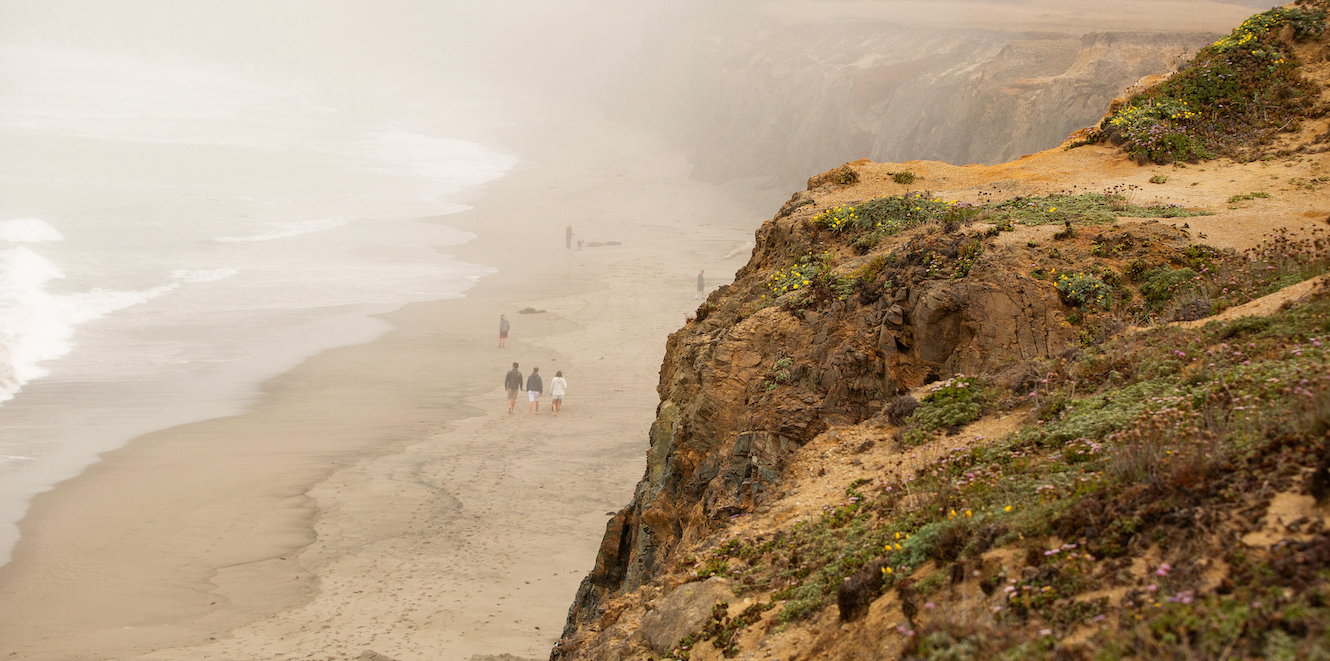It’s foggy beach time on the Sonoma Coast
By Stephen Nett
It's summer on the Sonoma Coast - and that means you'll likely find banks of damp, gray fog in the mornings and evening. From Doran Beach to Gualala Point, it’s a natural feature and a chilling experience. But that cool gray mist is also a vital lifeline.
While you’re waiting for the sun to appear, coastal plants are getting an essential drink. Fog can be their only source of water for six to eight months at a time. It’s so vital, many species have developed special ways of pulling a drink from thin air.

Sonoma Coast plants need summer fog
Basically, fog is just clouds on the ground, no different from the puffy white clouds in the sky. They’re both made of floating water droplets, as tiny as household dust or red blood cells.
But those droplets can add up to a considerable amount of water. There’s about a half a gram of drinkable water in a cubic yard of fog. A cubic mile can carry as much as 50,000 gallons of water.
For thirsty creatures along the Sonoma Coast, the fog drifting in from the sea is a real lifeline, and many have specially adapted features that let them capture some of the drifting moisture.
The giant coast redwood trees, for example, have customized leaves that absorb water right out of the air. Coast redwoods are water lovers, and they can’t survive without the summertime fog. That’s why you don’t find their forests any further inland than the fog bank will reach. Up to 40% of their water comes from fog. A large redwood tree can absorb as much as 14 gallons an hour from wet leaves.

Redwoods can make their own rain
Redwoods and other trees have another way of wringing a drink from the fog bank. Their waxy leaves comb the fog and attract droplets, which collect and then drip down to the forest floor, where their roots can absorb them. If you’ve ever camped beneath the redwood canopy in Gualala Point Regional Park, you’ve probably experienced this forest ‘rain’ pattering on your tent in the early morning.
The redwood ‘rain’ also benefits other forest dwellers that live beneath the canopy, including ferns, lichen and sorrel as well as insects and small animals.
Like the redwoods, the broad emerald fronds of the western sword fern can also take water directly from fog.

Fog combing and cooling
Coastal prairie plants also have special structures to turn mist to drinkable droplets. Walk early on a foggy day and you might see some. Glistening silver water drops line lupine leaves on gray days. Their hand-like leaflets are covered in tiny hairs that collect passing moisture.
Feathery grass tops and other plants can catch an amazing amount of water in just a few hours, enough to get your shoes and pants soaking wet if you walk through them. The water drips down the stems to their roots. Native plants like wild roses and coyote bush are also good fog harvesters.
All that moist air helps keep plants from drying out as quickly, too.
There are other important benefits to giant drifting banks of fog. It’s natural air conditioning. Temperatures at the foggy coast can be 20 degrees or more cooler than just 10 miles further inland. Cooler streams also help young salmon and other fish survive in pools through the hot dry season.

What’s making it foggy?
But why do we have fog in the summer? It forms here in the warmer months because the ocean’s surface is colder then. Seasonal winds stir cold water up from the depths, and when summer-warmed moist air meets that cold water, the moisture condenses into droplets, creating fog.
When inland temperatures spike, that hot air rises and pulls the fog onshore along the coast. Even inland parks like Helen Putnam Regional Park near Petaluma can see foggy mornings as the sea air rolls east through gaps in the coastal hills.
All that gloomy gray may put a damper on summer trips for beach visitors, but for life on the coast, fog is vital. Think of it as cloud bathing and a refreshing part of the natural California experience.

Try some new seaside destinations
The Gualala river meets the Pacific here at the northern corner of Sonoma County, just off Highway 1. In addition to hiking trails, a wide beach and bluff-top prairie meadows, there’s a cozy campground out of the wind along the river, where you can launch your kayak or just stretch out beneath towering redwoods and chandelier bay trees.
Along coast Highway 1 in The Sea Ranch community are a series of public trails that provide short walks to the ocean at six points (pictured above). The Shell Beach trail runs through pines and a meadow to a wide, sandy beach with tide pools.
With 3 miles of hiking trails, a small campground, crescent beach and tidepools, the cove at Stillwater can be busy. But surrounded by forest with spectacular oceanfront and bluff top views, it’s a charming and magical destination. Walk inland along Stockhoff Creek on the Canyon Trail and you’ll pass through towering redwood groves.
Pinnacle Gulch Coastal Access Trail
This short trail leads to a wide and less frequently visited beach near Bodega Bay, with plenty of room to stretch legs with a leisurely barefoot stroll through the sand, explore rock formations and tidepools, picnic or watch sea birds passing through. During low tide, you can walk from Pinnacle Gulch to Doran Beach.
Stephen Nett is a Bodega Bay-based naturalist, writer and speaker.
Published July 2023.


 Translate
Translate